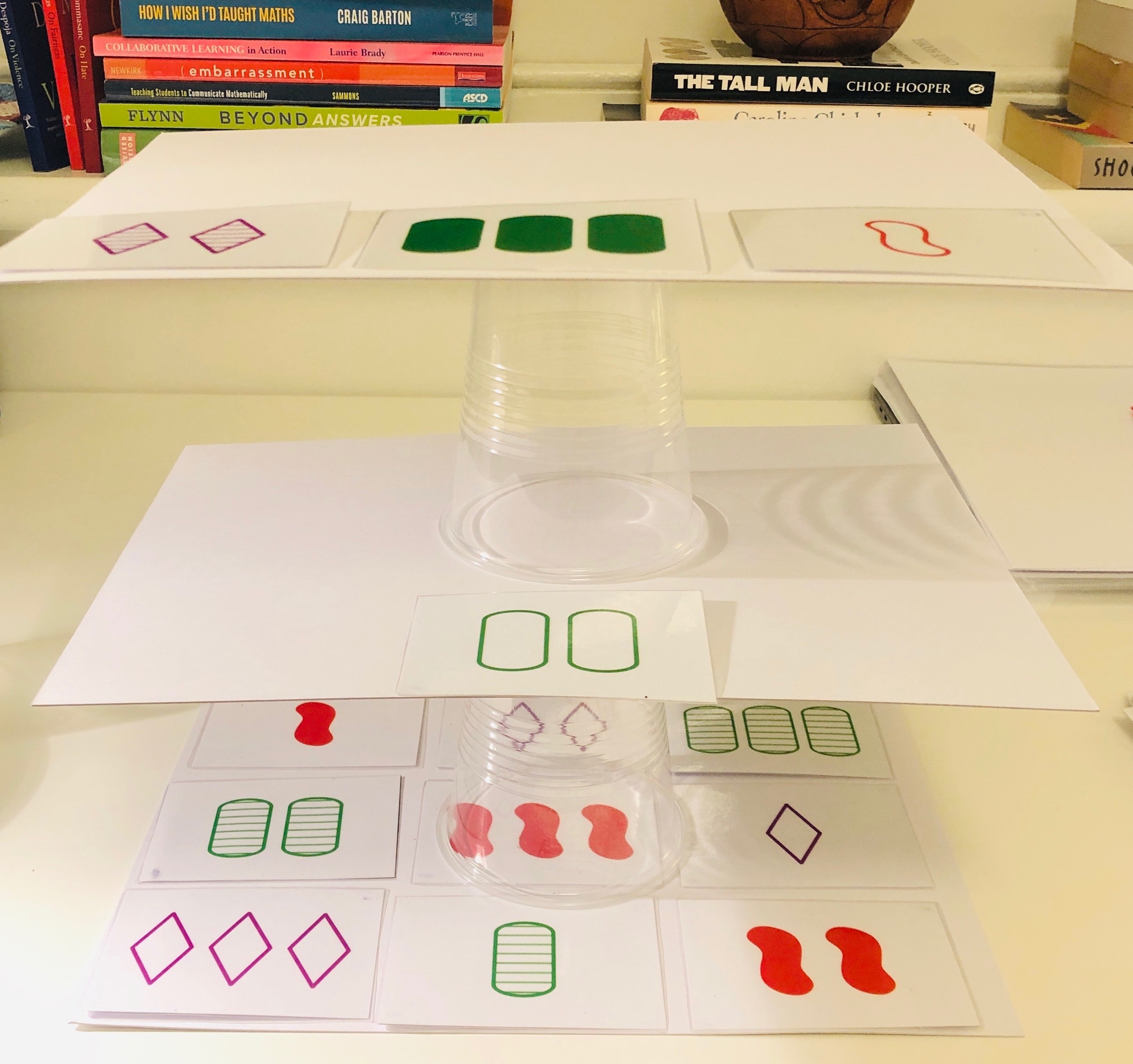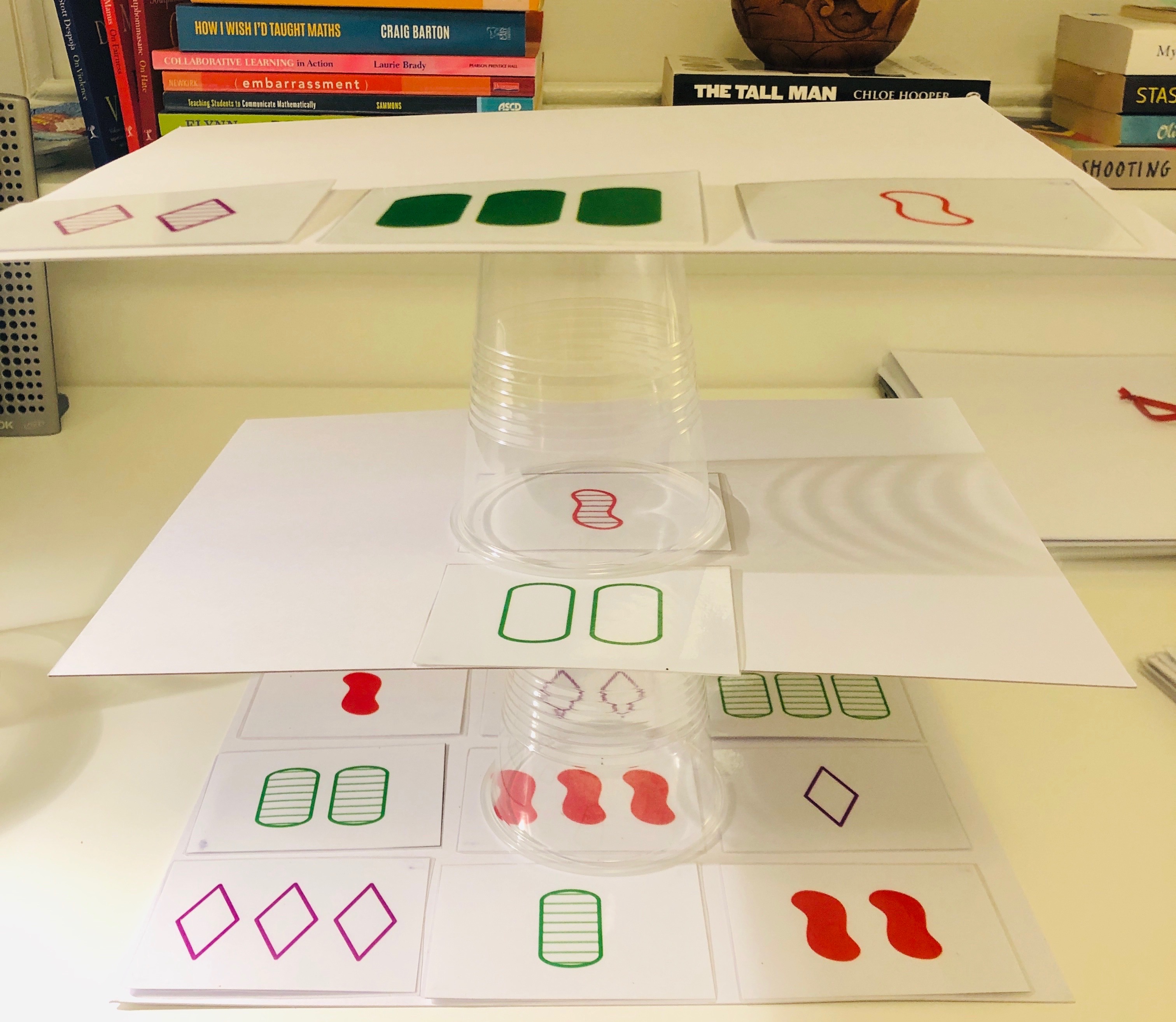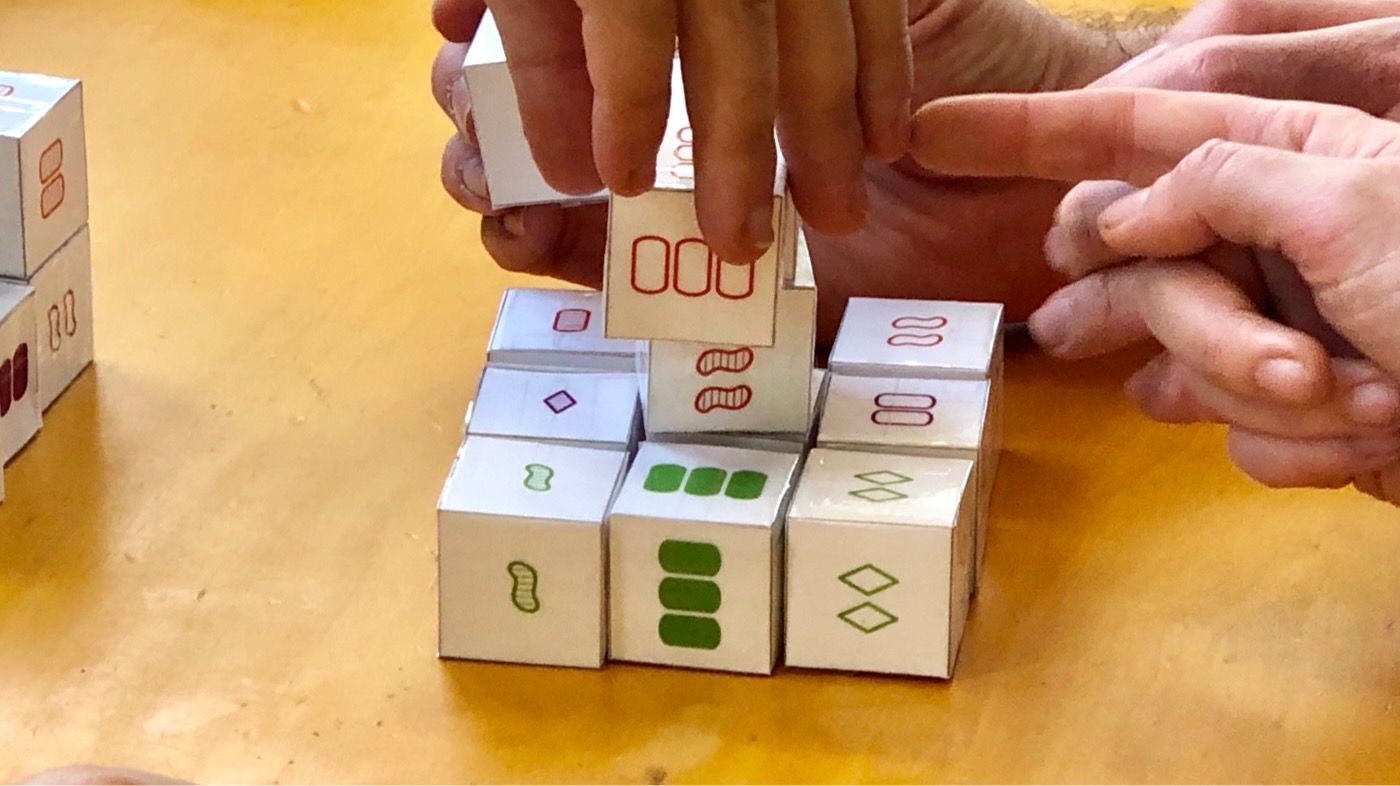SET is a card game that inspires many mathematical questions from players of all levels—from primary students to research mathematicians. Mathematical ideas in SET include counting and combinatorics, probability, geometry, modular arithmetic, vectors, and linear algebra. The book ‘The Joy of SET‘ is a very accessible deep dive into many of these topics. I’ve outlined some of my favourite counting questions in this early post on my blog, and in the second half of this blog post recounting a maths camp with primary school students.
In this post I’ll focus on the connections between geometry and the Game of SET. Specifically, I’ll run through the key questions and moments of workshops I run, and roughly follow the slides from my workshop at Twitter Math(s) Camp in 2018. They are in this folder, which is also jam-packed with other resources.
Warning: This post will contain lots of spoilers.
Introducing SET (a quick recap)
When introducing SET, I like to start with spreading out the cards and asking ‘What do you notice? What do you wonder?’ This is a great way to draw out the attributes, along with some other observations and questions that people might initially have.
There are four attributes of a SET card. The three cards below show all possible values of the attributes.

Question: If a SET deck contains exactly one card of every possible combination of attributes, how many cards are in a deck?
I like to get to this question by asking people to find a way to organise the cards so that they are convinced they have exactly one card with each combination of attributes. We can count how many cards there are, and also develop a combinatoric/counting argument.
I’ve noticed that when people organise the cards in this way, the idea of a SET tends to naturally arise. This is so much more powerful than me telling them!
Question: Can you come up with a definition of a SET?
I show four carefully chosen examples of SETs and ask people to come up with a definition of what constitutes a SET. This is a great way of exploring precision in definitions, as well as examples and not-examples.
A SET is a group of three cards where, for each of the four attributes, the features are the same across all three cards or different across all three cards. The three cards below are a SET because shape is all-same, fill is all-same, number is all-different, colour is all-different.

Interlude: Play the game
To play SET with others, lay twelve cards out on the table. The first person to find a SET calls ‘SET’, shows it to the rest of the players. The empty spaces are then replenished from the deck. If the players agree that there is no SET on the table, three more cards are dealt. At the end of the game, the person with the most SETs wins. David Butler has a nice variant of the game that involves playing in teams, and levels the competition when some participants are quicker at finding SETs than others.
Playing the game will allow participants to practice finding SETs, which will be useful later.
Question: Pick two cards at random. How many cards, if any, can be used to complete the SET?
Spoiler: The answer is 1. (Can you reason why?) This is called the Fundamental Theorem of SET, and is necessary for many geometric arguments that arise later.
Question: How many SETs are possible (including those where a card is used in more than one SET) among all cards in the deck?
Spoiler: a quick explanation. There are 81 choices for the first card in a SET, 80 choices for the second card, and 1 choice for the third card (by the Fundamental Theorem of SET). This gives 81*80*1. But! The order in which our cards are drawn doesn’t matter, so we have over-counted. We need to divide by the number of ways to arrange three cards, which is 3*2*1 = 3! = 6 ways. Thus, the total number of possible SETs is (81*80*1)/(3*2*1) = 1080.
Question: What is the most number of SETs among nine cards?
It’s perhaps better to pose this question as a challenge: Find nine cards with the most number of SETs among them. This question neatly segues into our geometric representation.
Representing SETs in two-dimensional affine geometry
Suppose we represent each SET card with a point in space. A line is a collection of three points that form a SET. We can visualise the 12 SETs among our nine cards as shown in the diagram below. Notice our lines bend; that’s okay!

What we’ve constructed here is a plane in space. There are a few ways to help people explore this fact. One is to start with familiar ideas about a geometric plane, that is, ‘three non-collinear points determine a plane’ and ‘if two points lie in a plane, then any line containing those two points also lies in that plane’.
In SET language, this means we should start with three cards (points) that do not form a SET (are not collinear). Then, for any two cards in our plane, the SET determined by those cards should be in the plane. This means that the third card required to complete the SET should also be a part of the plane. Starting with our three non-collinear points, we continue to add cards to the plane until we have exhausted all options.
We end up with nine cards in our plane. This collection of nine cards is called closed. That is, if we pick any pair of points, the point that completes the line lies in the plane.
Question: What is the most number of cards we can remove from our collection of nine and still be able to reconstruct all twelve SETs?
Rather than launch from the definition of a plane, I like to start by posing the question above. Eventually people arrive at three cards that don’t belong to the same SET. When we start making connections from here to geometry, it feels a little more concrete.
Interlude: Finite Affine Geometry
Did you know that there are lots of different kinds of geometries? To give an extremely non-technical explanation, Euclidean geometry (the one that we are most familiar with) is build on a set of axioms (statements that we take to be given truths). Axioms are the building blocks of mathematics and of geometries. Each branch of geometry has its own set of axioms or, put another way, each set of axioms gives rise to a unique branch of geometry (quoted from page 99 of ‘The Joy of SET’).
Our SET geometry belongs to a non-Euclidean branch of geometry called finite affine geometry: ‘finite’ because we have a finite number of points and lines, and ‘affine’ because parallel lines are allowed. (You might like to think about what it means to have two parallel SET lines!)
So far we have explored an affine plane called AG(2,3). (The 2 is for two dimensions; the 3 is for three points in a line). We can count objects in this geometry: 9 points, 12 lines, 1 plane. And remember, we just need 3 (non-collinear) cards to build our plane.
Let’s now move to three dimensions!
SET in three dimensions
To go to three dimensions we use a SET plane and one point off the plane. We then complete our hyperplane as we did before. That is, we select any two points in the hyperplane and add the third point that completes the line. I’ve started constructing a hyperplane below. Can you see a card that could be placed next?

I’ve used the ‘two empty green ovals’ card to place three more cards to the ‘topmost’ plane.

What cards could you add next? Well, we could finish off the ‘frontmost’ plane (the one formed by the three cards on the top level, the single card in the middle level, and the three front cards on the bottom level).
We could also use the top front left card (two striped purple diamonds) and the bottom back right card (three striped green ovals) to fill in the centre of the middle level (one striped red peanut/squiggly thing).

If we continue in this way, we’ll build AG(3,3). (The first 3 is for three dimensions; the 3 is for three points in a line). We can count objects in this geometry: 27 points, 117 lines, 39 planes, 1 hyperplane. (These numbers aren’t obvious; you’ll need some crafty counting/combinatorial constructions.)
What is the minimum number of points needed to construct the hyperplane? Well, we need three non-collinear points to construct a plane, and then one point off the plane. So we used four cards to build our hyperplane.
SET in four dimensions
We can move into four dimensions in the same way. We just need our hyperplane (from before) and a point off the hyperplane. The photo below was taken by Chrissie Newell at games night at the 2018 Twitter Math(s) Camp.

We’ve built AG(4,3), which has 81 points (the number of cards in a SET deck), 1080 lines (all possible SETs in the deck), 1170 planes, and 120 hyperplanes.
But why stop now?
What if we added another attribute to our SET deck, like size? Can you imagine what our five-dimensional hyperplane would look like now? I’ll leave it to you to try!

Practical matters
I run SET workshops with large groups, sometimes in different cities. I wanted a quick, cheap and portable set of materials for pairs/trios to use. My method of plastic cups and heavy card (or even clear perspex) works fairly well, and is relatively easy to lug around. (The heavy card and the SET cards themselves are a bit heavy in my suitcase, though.)
I have also made these gorgeous SET cubes.

The cubes are a labour of love. They involve cutting, folding, and taping every side of 81 little cubes. They take ages to make (many hours), but they are beautiful. The nets are in the folder I shared earlier. There are no instructions, but I think you can figure it out. You could also try affixing stickers to pre-made cubes, or even 3D printing cubes. If you find something that works, let me know!

The cubes are a lot of fun to play with …


A lovely summary! I especially like the cups&paper way to stack the planes, and I plan to use it myself. Thanks for this post.
Liz McMahon
LikeLike
I love the 3-D version and simple to set up using the plastic cups. Helen Booth
LikeLike